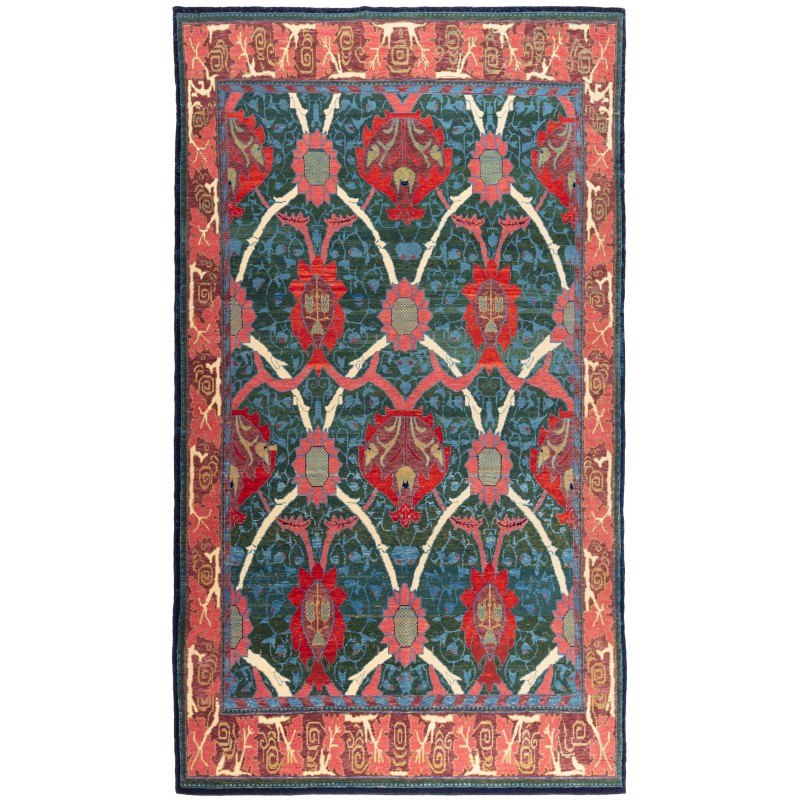
- Stock: In Stock
- Model: C50225
- サイズ: 175cm x 302cm
この絨毯の元になったのは、1991年にMalcolm HaslamとDavid Blackが出版した『Arts & Crafts Carpets』という本で、図49に掲載されています。このハマースミス絨毯は、1882年にイギリスのウィリアム・モリスによってデザインされました。1887年、英国の美術家兼装幀師であるT.J.コブデン・サンダーソンは、新しいグループに「アーツ・アンド・クラフツ展覧会協会」という名前を付けることを提案しました。その結果、彼は「アート・アンド・クラフツ」という用語を最初に使用し、この新興の運動に名前を付けることにも貢献しました。アーツ&クラフツ運動は、工場生産時代に生じた製品の品質の低下に触発されました。製造業における機械の台頭により、個性と職人技の低下が顕著になりました。これらの産業改革の反対者たちは、経済的な進歩と社会的な変革を推進しました。彼らは19世紀のイギリス社会から品質の低い「人工的な」アイテムを排除したいと考えていました。彼らは1851年のグレート展覧会で展示された無味乾燥なアイテムの過多を目にし、独自性と個性のためのキャンペーンを開始することにインスピレーションを受けました。
ウィリアム・モリスは、イギリスのデザイナーであり、社会活動家兼作家でもありました。モリスは、テキスタイルアートと伝統的な生産手法の再生を引き起こすことで名声を得ています。1861年、モリスと少数のデザイナーグループが非常に流行のあるデザイン会社を立ち上げ、大いに成功しました。モリスは、テキスタイル、書籍、家具、ステンドグラス、絨毯など、さまざまな媒体で作品を残しました。しかし、最終的には、彼がデザインした壮大な壁紙で最も記憶されています。彼は自然界から多くのインスピレーションを得ました。モリスのインテリアデコの作品を通じて、彼は部屋や空間を美しい木々が曲がりくねり、蔦や植物が広がる草原に変えることを目指しました。工業製品や人工物を自然なものに変えるというこのコンセプトは、ウィリアム・モリスがかつて言った「-何の意味もない装飾...それ自体以上のものを思い起こさないときは無駄だ」という言葉に象徴されています。
モリスは商業的な成功を収め、彼の作品はデザインとインテリアの世界で最も求められるものの一部です。彼はイギリスのテキスタイルアートとその生産方法の復興にほぼ独力で貢献しています。モリスは機械製品に対しても厳しい批判を行い、「ほとんどの文明人が作る品物はみすぼらしくて気取って醜い」と叫びました。家は「とてもとても言い表せないゴミでいっぱい」で、それは彼によれば巨大な焚き火の山に積み上げられるべきだったのです!「機械による生産は人生の条件として完全に悪である」と彼は言いました。彼はアーツ&クラフツの最も有名なスタイルの1つを立案し、それは曲がりくねり、弧を描く模様とシンプルでエレガントな花のデザインの印象的なものです。モリスはペルシャの絨毯がこれまでに作られた中で最も優れたものだと信じていましたが、彼自身の手織り絨毯の製造には粗いトルコ(ギョルデス)結びが採用されました。当時、1平方インチあたり25ノットの厚さで織られました。モリス&カンパニーの絨毯は、英国の庭園デザインの絨毯のようにスマートにスタイリングされたものです。ダニゴールも19世紀後半に非常に望ましいアイルランドの絨毯の製造を開始しました。ダニゴールの絨毯は主に英国の建築家C.F.A.ヴォイジーとギャビン・モートンによって作成されました。手作りのヴォイジーの絨毯は通常、イングランド、スコットランド、アイルランドで織られます。ヴォイジーは対照的な形状を使って平坦な単色の空間を装飾する才能を持っていました。濃い輪郭線が彼の特徴的なパターンやケルティックの絨毯のデザインにドラマを加えました。最初のダニゴールの絨毯は密なウールの基礎の上に手織りされました。ヴォイジーのデザインは他の多くのアーティストに影響を与え、類似の絨毯の数多くが登場することにつながりました。絨毯のデザインは私たちのデザイナーによって解釈され、鮮やかな色彩がこの絨毯に使用されています。
The source of carpet comes from the book Arts & Crafts Carpets, Malcolm Haslam, David Black, 1991, fig.49. This Hammersmith carpet was designed by William Morris in 1882, in the United Kingdom. In 1887 English artist and bookbinder T.J. Cobden Sanderson, suggested that a new group be named the “Arts and Crafts Exhibition Society” As a result, he was the first to use the term “Art and Crafts” and also is credited with naming this new emerging movement. The Arts & Crafts movement was inspired by the degradation of product standards that resulted from the factory production age. The rise of machinery in manufacturing caused a noticeable decline in uniqueness and crafts. These anti-industrial reformers promoted economic advancement and social change. They wanted to eliminate poor quality and “artificial” items from 19th-century British society. They saw a plethora of uninteresting items on display at the Great Exhibition of 1851 and became inspired to launch a campaign for originality and uniqueness.
William Morris was an English designer, as well as an uplifting social activist and writer. Morris is credited with sparking the rebirth of textile arts and traditional means of production. In 1861, Morris and a small group of designers opened an incredibly fashionable design company that grew to be largely successful. Morris left behind works in many different mediums such as textiles, books, furniture, stained glass, and area rugs. But in the end, he is most remembered for the magnificent wallpapers that he designed. He got much of his inspiration from the natural world. Through his interior decor pieces, Morris set out to convert rooms or spaces into meadows with beautiful trees meandering, vines and plants. This concept of taking something industrial and man-made, and converting it into something natural is what William Morris meant when he once said: “-any decoration is futile… when it does not remind you of something beyond itself.”
Morris was a huge commercial success and his works are some of the most sought-after pieces in the world of design and decor. He is also credited with almost single-handedly reviving the British textile arts as well as their methods of production. Morris was also severely critical of machine-made goods, exclaiming, “Today almost all wares that are made by civilized man are shabbily and pretentiously ugly.” Houses were filled “with tons and tons of unutterable rubbish,” which, he suggested, should be heaped onto a gigantic bonfire! “As a condition of life, production by machinery is altogether evil.” He masterminded one of the most well-known styles of Arts & Crafts, recognizable by its twisting and arching patterns and simple, elegant floral design prints. Although Morris believed that Persian carpets were the greatest ever made, he adopted the coarser Turkish (Ghiordes) knot for his own hand-knotted carpet manufacture. They were woven at a thickness of 25 knots to the square inch at that time. Morris & Co.’s rugs are reminiscent of Persian garden design carpets in that they are smartly styled depictions of English gardens. Donegal also started producing highly desirable Irish rugs in the late 19th century. The Donegal rugs were predominantly created by English architects C.F.A. Voysey and Gavin Morton. The hand-crafted Voysey rugs are typically woven in England, Scotland, and Ireland. Voysey had a knack for using contrasting shapes to decorate flat monochromatic spaces. Dark outlines added a flair of drama to his signature pattern and Celtic rug designs. The first Donegal rugs were hand-knotted over a dense wool foundation. Voysey’s designs inspired many other artists, leading to the appearance of a large volume of lookalike rugs. The design of the carpet is interpreted by our designers, and vivid colors are used for this carpet.
